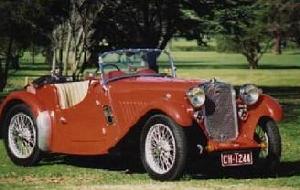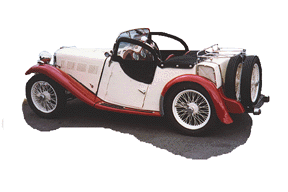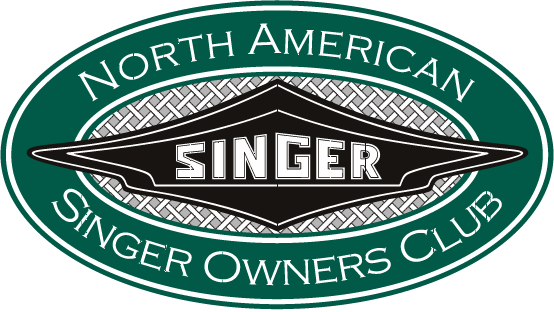9 Le Mans
The success of the Nine Sport at Le Mans led immediately to the introduction in 1933 of the first Le Mans model. This was the two seater equivalent of the Nine Sports and it typified the British sports car of the 1930’s. At a price of 215 pounds, an output of 34 h.p. and a top speed of over 70 m.p.h. with the windshield lowered, it provided keen competition for its closest rivals, the J2 and P series M.G.’s.
The Le Mans was fitted with the same 972 cc engine as the four seater, albeit with high lift harmonic cams, a counterbalanced crankshaft and an extra large capacity ribbed oil sump for greater cooling capacity.  Additional drive train modifications included a heavy duty clutch and a closer ratio gear box, with third gear reduced from 8.7:1 to 7.5:1. Body changes included the addition of an externally mounted 12 gallon slab fuel tank, fitted with a quick action filler cap and twin rear mounted spare tires to complete the competition look. The new upswept scuttle cowls also signaled that this was a machine that meant business on the road as well as the track.
Additional drive train modifications included a heavy duty clutch and a closer ratio gear box, with third gear reduced from 8.7:1 to 7.5:1. Body changes included the addition of an externally mounted 12 gallon slab fuel tank, fitted with a quick action filler cap and twin rear mounted spare tires to complete the competition look. The new upswept scuttle cowls also signaled that this was a machine that meant business on the road as well as the track.
One of the most significant engineering changes was the dropped frame which differentiated the Le Mans substantially from the 4 seater, lowering its centre of gravity for enhanced road handling. Optional equipment included two spare competition tires, 1 full size or 2 half-size suitcases, a bonnet strap and fittings, a route card holder, competition number plates and a combined chronometer and stop clock.
For 1935, a Special Speed version of the Le Mans was added to the Singer line up. At 225 pounds, changes included the introduction of running boards, which followed the line of the front fenders, extra interior room, obtained by moving the two spare  wheels rearward and a larger 13.5 gallon fuel tank.
wheels rearward and a larger 13.5 gallon fuel tank.
Engine output was increased to over 38 h.p. by raising the compression from 7:1 to 7.4:1, adding a higher lift cam, bigger valves and changing carburation from twin downdraft to twin horizontal S.U.’s. The coil ignition system was also replaced by the Swiss Scintilla Vertical Magneto, for a more consistent ignition spark. All of this, but perhaps most particularly the change in camhaft, produced an engine that ran more quietly, with a less pronounced exhaust note.The Special Speed would eventually supersede the basic Le Mans model for the production years of 1936 and 1937.
A Le Mans Four Seater was also produced during the 1935 model year. A hybrid of the Le Mans two seater and the Nine Sports, it featured upswept cowl scuttles with a streamlined tail end.
9 Le Mans Specs
Engine
Four cylinder, 60 mm. by 86 mm. = 972 c.c.
Treasury rating, 8.93 h.p.; tax 9 pounds
Valves operated by chain driven overhead camshaft
Alloy pistons
Coil ignition with automatic spark advance for Le Mans / Special Speed Scintilla magneto
Twin S.U. downdraft carburators for Le Mans / twin S.U. horizontal for Special Speed
Fan assisted cooling
Vibro damping engine mountings
Gearbox and Transmission
Four speeds with ratios 5.57, 7.5, 12.4 and 24.4 to 1and 33.6:1 reverse
Silent second and third gears
Remote control shift lever
Single dry plate, solid centre, heavy duty clutch
Open propeller shaft with Hardy Spicer mechanical universal joints
Spiral bevel rear axle
Wheels and Brakes
18 inch Rudge-Whitworth knock on wheels
4.50 X 18 inch tires
Four wheel Lockheed hydraulic brakes, 10 inch drums
General
12 volt lighting and starting system
Wheelbase 7 ft. 8 ins. with 8 inch ground clearance
Price
215 pounds for the Le Mans / 225 pounds for the Special Speed\
